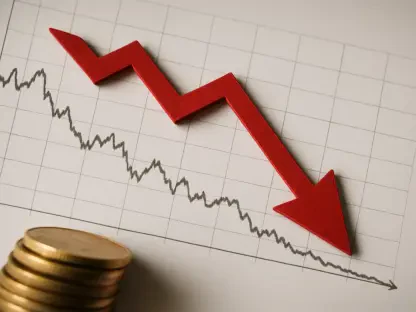In an era marked by economic turbulence, the sweeping policy changes introduced during the Trump administration have sent shockwaves through global markets and commodity sectors, creating a landscape of uncertainty that continues to challenge investors and policymakers alike. Tariffs, regulatory overhauls, and direct confrontations with central banking authorities have not only reshaped trade relationships but also introduced unprecedented volatility into equities and raw material pricing. From the S&P 500 struggling to break out of a tight trading range to copper prices facing downward pressure on international exchanges, the ripple effects of these policies are evident across multiple asset classes. As defensive sectors gain traction amid fears of ongoing trade disputes, and emerging markets present new opportunities, the financial world grapples with both risks and prospects. This complex environment demands a closer examination of how such policy shifts influence market dynamics, sector performance, and investment strategies in a fragmented global economy.
Unpacking Market Volatility and Sector Shifts
The hallmark of Trump-era policies has been a persistent uncertainty that keeps global markets on edge, with trade tariffs playing a central role in driving volatility across equity indices. The S&P 500, for instance, remains confined to a narrow band between 5,200 and 5,800, as investors adopt a cautious stance amid fears of escalating trade tensions. Defensive sectors like utilities and healthcare have become relative bastions of stability, consistently outperforming more cyclical industries such as industrials and materials, which bear the brunt of tariff-related cost increases. A notable example is Tesla (TSLA), which initially saw gains from reduced competition but has since encountered supply chain disruptions, contributing to significant stock declines due to rising input expenses. For investors navigating this terrain, a strategic tilt toward defensive equities and exchange-traded funds like XLU (utilities) and XLV (healthcare) appears prudent, while exposure to sectors vulnerable to trade policies should be carefully monitored to avoid potential downturns.
Beyond the immediate fluctuations in stock indices, the broader implications of these policies reveal a structural realignment within global markets that demands adaptive investment approaches. The heightened volatility is not merely a short-term phenomenon but a reflection of deeper trade disputes that continue to unsettle economic forecasts. Industries heavily reliant on international supply chains face persistent challenges, with increased costs eroding profit margins and forcing companies to reassess operational strategies. Meanwhile, sectors less exposed to global trade frictions are attracting capital as safe havens, reshaping portfolio allocations. Investors are advised to prioritize resilience by focusing on companies with strong domestic footprints and to consider diversified funds that mitigate risks associated with tariff-sensitive markets. This evolving landscape underscores the necessity of agility in investment decision-making, ensuring that portfolios are positioned to withstand policy-driven shocks while capitalizing on pockets of stability.
Commodity Markets Under Tariff Pressure
Tariffs imposed on key commodities such as copper and aluminum have significantly disrupted global pricing mechanisms, creating a challenging environment for both producers and consumers. With tariffs reaching as high as 50% on certain metals, prices on platforms like the London Metal Exchange (LME) are projected to dip below $9,100 per ton for copper in the near term. Domestic producers like Nucor (NUE) and Cleveland-Cliffs (CLF) have capitalized on this shift, gaining market share as imported materials become costlier. However, the energy sector faces collateral damage, with firms reporting substantial cost increases due to reliance on tariff-impacted steel, raising concerns about stagflation risks. For those looking to navigate this market, investments in domestic metal producers and energy companies with U.S.-centric supply chains, such as ExxonMobil (XOM) and Chevron (CVX), are recommended, alongside a cautious exploration of renewable energy leaders like NextEra Energy (NEE) that may offer long-term stability.
The cascading effects of these commodity tariffs extend beyond immediate price changes, influencing broader economic dynamics and heightening inflationary pressures. As costs rise for raw materials critical to infrastructure and manufacturing, businesses across various sectors are compelled to pass on expenses to consumers, further straining global supply chains already stretched thin by geopolitical tensions. This environment of elevated costs poses unique challenges for energy companies, which must balance operational efficiency with profitability amid fluctuating input prices. Strategic investment in firms that prioritize localized production can serve as a buffer against international market disruptions. Additionally, the pivot toward renewable energy sources presents an alternative avenue for mitigating risks tied to traditional commodity dependencies, offering a forward-looking approach to portfolio construction in an era defined by policy-driven economic fragmentation.
Central Bank Challenges and Hedging Strategies
The erosion of central bank independence under political pressures from Trump’s administration has introduced a new layer of anxiety into financial markets, with public criticisms of the Federal Reserve amplifying inflationary expectations. Market indicators such as the VIX index, which has surged above 30, and Treasury yields climbing to 5%, reflect deep-seated concerns over monetary policy stability. This politicization threatens to undermine confidence in traditional economic stabilizers, prompting investors to seek alternative safeguards. Hedging against such uncertainty through short-duration bonds like TLT and safe-haven assets such as gold (GLD) is increasingly viewed as a necessary tactic. Furthermore, sectors relatively insulated from trade disputes, particularly AI-driven technology firms like NVIDIA (NVDA), offer a counterbalance due to robust domestic innovation and demand, providing a viable diversification strategy in turbulent times.
Navigating the intersection of monetary policy and market sentiment requires a nuanced understanding of how political rhetoric can sway economic outcomes, often independent of fundamental data. The Federal Reserve’s ability to steer inflation and interest rates is now viewed through a lens of skepticism, as threats to replace key figures like Chairman Jerome Powell fuel speculation about future policy directions. This uncertainty compels a reevaluation of traditional investment frameworks, pushing portfolios toward assets that can weather sudden shifts in economic governance. Beyond conventional hedges, the technology sector’s resilience—driven by significant investments in AI infrastructure—stands out as a beacon for growth amid broader instability. Allocating capital to tech-focused funds and emerging innovations can help balance the risks posed by a politically charged monetary environment, ensuring a more robust defense against unforeseen policy pivots.
Emerging Opportunities Amid Trade Dynamics
Despite the overarching challenges, Trump-era policies have inadvertently opened doors to unique investment opportunities, particularly in regions and sectors benefiting from redirected trade flows. Latin American nations like Brazil and Mexico are witnessing increased capital inflows as companies seek lower-cost production alternatives amid U.S.-China trade frictions. Simultaneously, domestic tech giants have ramped up investments in AI infrastructure, sustaining demand for companies such as AMD and NVIDIA (NVDA). For investors, this presents a chance to allocate resources to emerging market ETFs like EEM and AI-focused funds such as VGT, while exercising caution around sectors exposed to retaliatory tariffs, including solar energy components. This dynamic underscores the dual nature of current trade policies, where disruption in one area often catalyzes growth in another, rewarding those who can identify and act on asymmetric opportunities.
The reconfiguration of global trade relationships also highlights the importance of strategic diversification as a means to capitalize on shifting economic currents. As traditional markets face ongoing pressures, emerging economies are stepping into roles previously dominated by larger players, offering fresh avenues for growth. The substantial capital being funneled into AI and related technologies by U.S. firms further reinforces the sector’s appeal as a hedge against trade volatility, with billions committed to innovation ensuring sustained momentum. Investors are encouraged to adopt a balanced approach, blending exposure to these high-growth areas with careful risk assessment of industries vulnerable to policy retaliation. By focusing on structural shifts rather than temporary disruptions, portfolios can be positioned to leverage the evolving landscape of international commerce, turning policy challenges into actionable prospects for long-term gains.
Reflecting on a Fragmented Economic Legacy
Looking back, the tariff and regulatory policies of the Trump administration left an indelible mark on global markets, weaving a tapestry of volatility and opportunity that defined economic interactions for years. The persistent uncertainty reshaped investment strategies, pushing a focus on defensive sectors while highlighting domestic strengths in commodities like metals and energy. Hedging against policy unpredictability became a cornerstone of financial planning, as did the pursuit of growth in AI and emerging markets. The lasting lesson was the necessity of adaptability, with investors who embraced diversification and agility finding pathways through the chaos. Moving forward, the emphasis should remain on crafting resilient portfolios that can withstand geopolitical shocks, leveraging ETFs for broad exposure, and staying attuned to structural economic shifts. This era, though fraught with challenges, underscored that strategic foresight could transform uncertainty into a catalyst for innovative investment approaches.









